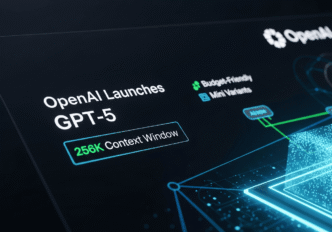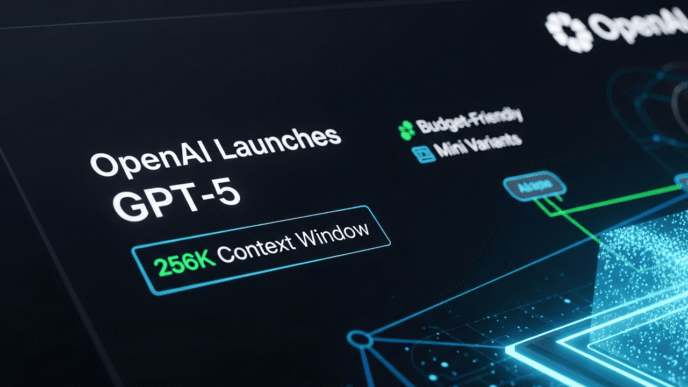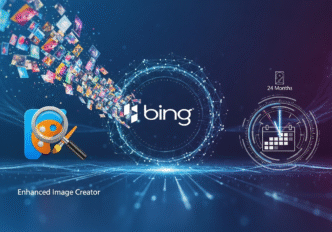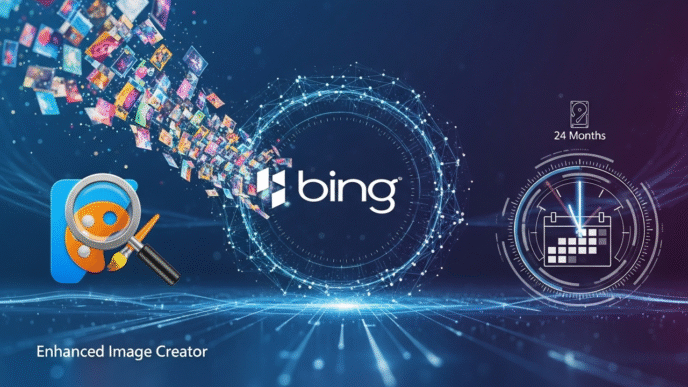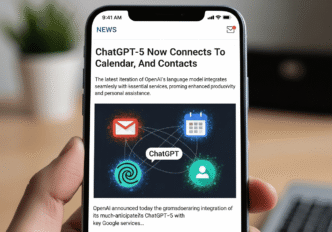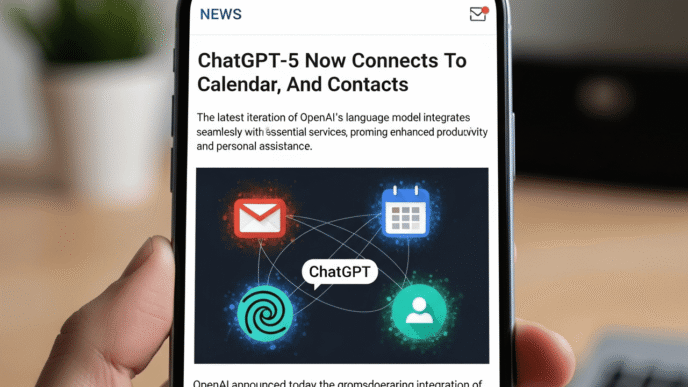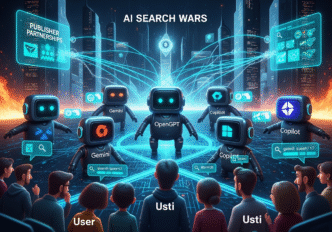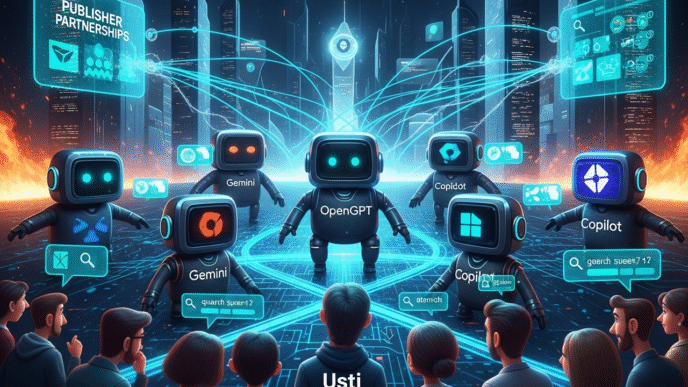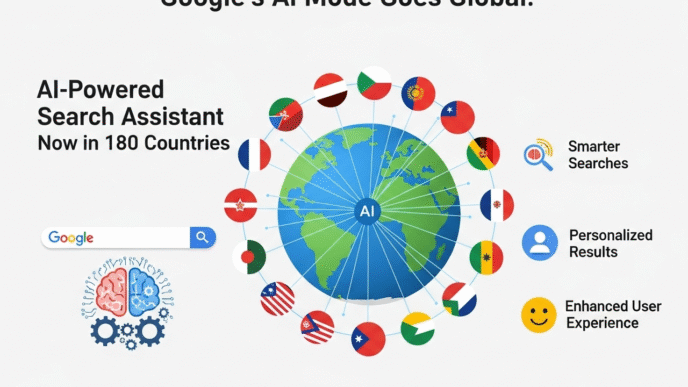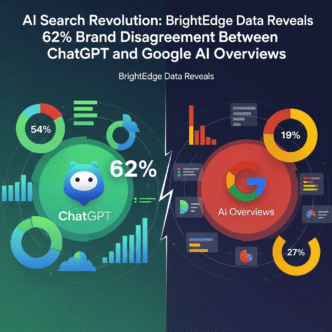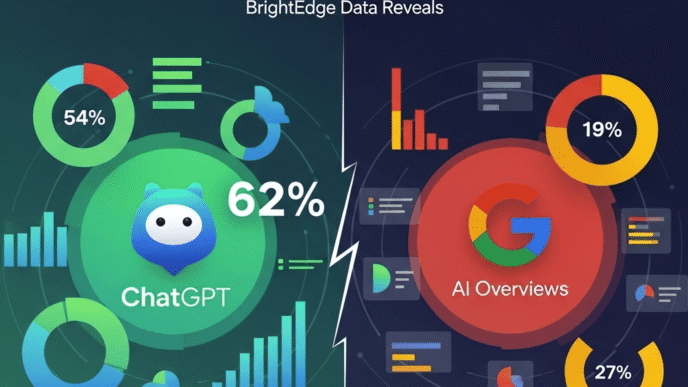Table of Contents
ToggleExecutive Summary
The digital landscape has reached a pivotal moment. Between January and May 2025, traffic from AI assistants surged by an unprecedented 527%, signaling the most significant shift in web discovery since the advent of social media. This comprehensive analysis examines how platforms like ChatGPT, Perplexity, Claude, Gemini, and Copilot are fundamentally altering user behavior and creating new pathways to content discovery.
Key Findings:
- AI-referred sessions jumped from 17,076 to 107,100 across 19 GA4 properties in five months
- Some SaaS companies now receive over 1% of total traffic from AI platforms
- High-trust industries (Legal, Finance, Health) capture 55% of AI-driven sessions
- ChatGPT leads the pack, but the competitive landscape is rapidly diversifying
The Numbers Behind the Revolution
Traffic Growth Trajectory
The 527% increase in AI-referred traffic represents more than statistical growth—it signals a fundamental behavioral shift. According to Previsible’s comprehensive analysis published in Search Engine Land, this growth pattern is consistent across multiple industries and represents the fastest adoption of any new digital channel in recent history.
To put this in perspective:
- January 2025: 17,076 AI-sourced sessions
- May 2025: 107,100 AI-sourced sessions
- Growth Rate: 527% in just five months
One standout example saw ChatGPT traffic alone grow from 600 visits per month in early 2024 to over 22,000 visits per month by May 2025—a 3,567% increase for a single platform.
💡 Pro Tip: Track AI referral traffic in Google Analytics 4 by setting up custom dimensions for referral sources including “chat.openai.com,” “perplexity.ai,” and “claude.ai” to monitor your own AI discovery performance.
Industry Distribution
The surge isn’t uniform across all sectors. High-consultative industries are leading the charge, as documented in Search Engine Journal’s analysis of AI traffic patterns:
Top Performing Industries:
- Legal Services – Complex regulatory questions drive AI consultations
- Finance & Banking – Users seek personalized financial advice and explanations
- Healthcare – Medical inquiries and symptom research dominate queries
- Insurance – Policy comparisons and coverage explanations
- SMB Consulting – Business strategy and operational guidance
These five industries collectively account for 55% of all AI-driven sessions, highlighting users’ preference for AI assistance with complex, high-stakes decisions.
💡 Pro Tip: If you’re in a high-trust industry, prioritize creating comprehensive FAQ sections and expert-authored content, as these formats perform exceptionally well in AI discovery scenarios.
Platform Landscape Analysis
ChatGPT’s Dominance
ChatGPT continues to lead the AI traffic generation, but its monopoly is weakening. The platform benefits from:
- First-mover advantage in consumer AI
- Superior natural language processing
- Broad general knowledge capabilities
- Strong brand recognition
Emerging Competitors
Perplexity has gained significant traction with its search-focused approach, offering:
- Real-time web search integration
- Source citations and transparency
- Specialized research capabilities
Google’s Gemini leverages integration advantages:
- Native Google ecosystem integration
- Android device pre-installation
- Seamless transition from traditional search
Microsoft Copilot capitalizes on enterprise relationships:
- Office 365 integration
- Business-focused use cases
- Professional workflow optimization
Anthropic’s Claude appeals to quality-conscious users:
- Reputation for accuracy and safety
- Longer context windows
- Nuanced reasoning capabilities
User Behavior Transformation
The “Instant Surfacing Era”
Traditional SEO operated on a crawl-index-rank cycle that rewarded patience and authority building. AI discovery operates differently, as explained in Ahrefs’ comprehensive study on AI search behavior:
Old Model: Publish → Wait for crawling → Hope for indexing → Optimize for ranking → Generate traffic
New Model: Create quality content → Get immediately surfaced by AI → Receive targeted referrals
This shift means content can be discovered and drive traffic before it even ranks in traditional search engines.
💡 Pro Tip: Focus on creating content that directly answers specific questions rather than optimizing for broad keywords. AI models excel at understanding intent and context, making traditional keyword density tactics less effective.
Quality Over Quantity
AI platforms prioritize content that is:
- Clear and structured – Easy for models to parse and understand
- Authoritative – From recognized experts or institutions
- Comprehensive – Covers topics thoroughly rather than superficially
- Current – Up-to-date information that reflects latest developments
Business Implications
For SaaS Companies
Some SaaS businesses are already seeing over 1% of total traffic from AI platforms. While this might seem modest, it represents:
- High-intent users who have actively sought AI assistance
- Qualified prospects who’ve engaged with AI to solve specific problems
- Bottom-funnel traffic with higher conversion potential
For Content Publishers
The implications vary significantly by content type:
Winners:
- Educational content creators
- How-to and tutorial publishers
- Industry analysis and research firms
- Expert commentary and opinion sites
Challenges:
- Breaking news publishers (AI prefers verified information)
- Listicle and aggregation sites (AI can synthesize directly)
- SEO-optimized but thin content creators
For E-commerce
AI discovery is particularly powerful for complex purchase decisions, as highlighted in Adobe’s recent analysis of AI-driven retail traffic:
- Electronics – Specification comparisons and recommendations
- Healthcare products – Safety and efficacy information
- Financial services – Product feature explanations
- Professional services – Capability and pricing inquiries
💡 Pro Tip: Create detailed product comparison guides and technical specification sheets, as AI assistants frequently reference these when helping users make purchase decisions.
Strategic Recommendations
Immediate Actions (0-3 months)
Content Optimization:
- Restructure existing content with clear headers and bullet points
- Add FAQ sections that directly answer common queries
- Include expert credentials and authority signals
- Ensure information accuracy and currency
Technical Preparation:
- Implement structured data markup
- Optimize for featured snippets
- Ensure fast loading times and mobile optimization
- Create XML sitemaps with updated lastmod tags
Medium-term Strategy (3-12 months)
Authority Building:
- Develop thought leadership content
- Seek expert citations and backlinks
- Build relationships with industry authorities
- Create comprehensive resource hubs
AI-First Content Creation:
- Design content specifically for AI consumption
- Focus on answering complete questions rather than keyword optimization
- Create content that provides context and nuance
- Develop expertise-driven content series
Long-term Vision (12+ months)
Platform Diversification:
- Develop relationships with multiple AI platforms
- Create platform-specific content strategies
- Monitor emerging AI discovery channels
- Build direct AI API integrations where possible
Measurement Evolution:
- Develop new KPIs beyond traditional traffic metrics
- Track AI mention frequency and context
- Monitor brand authority signals
- Measure assisted conversions from AI discovery
Challenges and Considerations
Attribution Complexity
AI-driven traffic often involves multiple touchpoints, as detailed in Kevin Indig’s user experience study of AI Overviews:
- Initial discovery through AI
- Verification through traditional search
- Social proof seeking on platforms like Reddit
- Final conversion on the target website
This multi-step journey makes traditional attribution models inadequate.
💡 Pro Tip: Implement UTM parameters for AI referral traffic and set up custom conversion paths in Google Analytics to better understand the full user journey from AI discovery to conversion.
Content Investment ROI
The shift requires significant content strategy changes:
- Higher upfront investment in comprehensive content
- Longer content development cycles
- Greater emphasis on expertise and authority
- Reduced reliance on keyword-driven content
Competitive Dynamics
As more businesses optimize for AI discovery:
- Competition for AI attention will intensify
- Authority and trust signals will become more valuable
- First-mover advantages will compound
- Smaller players may struggle to gain AI visibility
Future Outlook
Growth Projections
If current trends continue, AI-referred traffic could represent:
- 5-10% of total website traffic by end of 2025
- 15-20% for high-trust industries by 2026
- Major revenue channel for information-based businesses
Technology Evolution
Expected developments include:
- Improved accuracy reducing user verification needs
- Better source attribution providing clearer traffic attribution
- Industry-specific AI models creating niche opportunities
- Voice and visual AI search expanding discovery channels
Market Maturation
The AI discovery market will likely evolve through:
- Platform consolidation as winners emerge
- Specialized AI services for specific industries
- Direct publisher partnerships with AI platforms
- New monetization models beyond traditional advertising
Conclusion: Preparing for the AI-First Future
The 527% surge in AI-driven traffic is not a temporary spike—it’s the beginning of a fundamental shift in how people discover and consume information online. Organizations that recognize this trend early and adapt their content and discovery strategies accordingly will capture disproportionate value in the emerging AI-first digital ecosystem.
The companies thriving in this new landscape will be those that prioritize authority, clarity, and genuine expertise over traditional SEO tactics. As AI becomes the primary discovery layer for complex information, the winners will be those who can effectively communicate their knowledge through these new channels while maintaining the trust and credibility that AI platforms increasingly value.
The question is no longer whether AI will reshape web discovery—it’s whether your organization will be ready to succeed in this new reality.
Additional Resources
Essential Reading:
- Previsible’s 2025 AI Traffic Study – Complete methodology and findings
- Search Engine Land’s AI Search Coverage – Latest industry trends and analysis
- Ahrefs’ AI Overviews Research – Technical insights and click-through rate data
Tools for AI Discovery Tracking:
- Previsible’s Free AI Traffic Dashboard – Monitor LLM referrals in Looker Studio
- SE Ranking’s AI Overview Tracker – Track AI visibility and citations
- Google Analytics 4 – Set up custom dimensions for AI referral sources
💡 Final Pro Tip: Subscribe to AI platform newsletters and developer updates to stay informed about algorithm changes that could affect your content’s discoverability in AI search results.
This report is based on analysis from Previsible’s 2025 AI Traffic Study, examining 19 GA4 properties across multiple industries and timeframes.

, this growth pattern is consistent across multiple industries and represents the fastest adoption of any new digital channel in recent history. To put this in perspective: - **January 2025:** 17,076 AI-sourced sessions - **May 2025:** 107,100 AI-sourced sessions - **Growth Rate:** 527% in just five months One standout example saw ChatGPT traffic alone grow from 600 visits per month in early 2024 to over 22,000 visits per month by May 2025—a 3,567% increase for a single platform. **💡 Pro Tip:** Track AI referral traffic in Google Analytics 4 by setting up custom dimensions for referral sources including "chat.openai.com," "perplexity.ai," and "claude.ai" to monitor your own AI discovery performance. ### Industry Distribution The surge isn't uniform across all sectors. High-consultative industries are leading the charge, as documented in [Search Engine Journal's analysis of AI traffic patterns](https://www.searchenginejournal.com/study-chatgpt-ai-tools-gain-ground-in-search-market/536137/): **Top Performing Industries:** 1. **Legal Services** - Complex regulatory questions drive AI consultations 2. **Finance & Banking** - Users seek personalized financial advice and explanations 3. **Healthcare** - Medical inquiries and symptom research dominate queries 4. **Insurance** - Policy comparisons and coverage explanations 5. **SMB Consulting** - Business strategy and operational guidance These five industries collectively account for **55% of all AI-driven sessions**, highlighting users' preference for AI assistance with complex, high-stakes decisions. **💡 Pro Tip:** If you're in a high-trust industry, prioritize creating comprehensive FAQ sections and expert-authored content, as these formats perform exceptionally well in AI discovery scenarios. ## Platform Landscape Analysis ### ChatGPT's Dominance ChatGPT continues to lead the AI traffic generation, but its monopoly is weakening. The platform benefits from: - First-mover advantage in consumer AI - Superior natural language processing - Broad general knowledge capabilities - Strong brand recognition ### Emerging Competitors **Perplexity** has gained significant traction with its search-focused approach, offering: - Real-time web search integration - Source citations and transparency - Specialized research capabilities **Google's Gemini** leverages integration advantages: - Native Google ecosystem integration - Android device pre-installation - Seamless transition from traditional search **Microsoft Copilot** capitalizes on enterprise relationships: - Office 365 integration - Business-focused use cases - Professional workflow optimization **Anthropic's Claude** appeals to quality-conscious users: - Reputation for accuracy and safety - Longer context windows - Nuanced reasoning capabilities ## User Behavior Transformation ### The "Instant Surfacing Era" Traditional SEO operated on a crawl-index-rank cycle that rewarded patience and authority building. AI discovery operates differently, as explained in [Ahrefs' comprehensive study on AI search behavior](https://ahrefs.com/blog/ai-overviews-reduce-clicks/): **Old Model:** Publish → Wait for crawling → Hope for indexing → Optimize for ranking → Generate traffic **New Model:** Create quality content → Get immediately surfaced by AI → Receive targeted referrals This shift means content can be discovered and drive traffic before it even ranks in traditional search engines. **💡 Pro Tip:** Focus on creating content that directly answers specific questions rather than optimizing for broad keywords. AI models excel at understanding intent and context, making traditional keyword density tactics less effective. ### Quality Over Quantity AI platforms prioritize content that is: - **Clear and structured** - Easy for models to parse and understand - **Authoritative** - From recognized experts or institutions - **Comprehensive** - Covers topics thoroughly rather than superficially - **Current** - Up-to-date information that reflects latest developments ## Business Implications ### For SaaS Companies Some SaaS businesses are already seeing over 1% of total traffic from AI platforms. While this might seem modest, it represents: - **High-intent users** who have actively sought AI assistance - **Qualified prospects** who've engaged with AI to solve specific problems - **Bottom-funnel traffic** with higher conversion potential ### For Content Publishers The implications vary significantly by content type: **Winners:** - Educational content creators - How-to and tutorial publishers - Industry analysis and research firms - Expert commentary and opinion sites **Challenges:** - Breaking news publishers (AI prefers verified information) - Listicle and aggregation sites (AI can synthesize directly) - SEO-optimized but thin content creators ### For E-commerce AI discovery is particularly powerful for complex purchase decisions, as highlighted in [Adobe's recent analysis of AI-driven retail traffic](https://searchengineland.com/generative-ai-surging-online-shopping-report-453312): - **Electronics** - Specification comparisons and recommendations - **Healthcare products** - Safety and efficacy information - **Financial services** - Product feature explanations - **Professional services** - Capability and pricing inquiries **💡 Pro Tip:** Create detailed product comparison guides and technical specification sheets, as AI assistants frequently reference these when helping users make purchase decisions. ## Strategic Recommendations ### Immediate Actions (0-3 months) **Content Optimization:** - Restructure existing content with clear headers and bullet points - Add FAQ sections that directly answer common queries - Include expert credentials and authority signals - Ensure information accuracy and currency **Technical Preparation:** - Implement structured data markup - Optimize for featured snippets - Ensure fast loading times and mobile optimization - Create XML sitemaps with updated lastmod tags ### Medium-term Strategy (3-12 months) **Authority Building:** - Develop thought leadership content - Seek expert citations and backlinks - Build relationships with industry authorities - Create comprehensive resource hubs **AI-First Content Creation:** - Design content specifically for AI consumption - Focus on answering complete questions rather than keyword optimization - Create content that provides context and nuance - Develop expertise-driven content series ### Long-term Vision (12+ months) **Platform Diversification:** - Develop relationships with multiple AI platforms - Create platform-specific content strategies - Monitor emerging AI discovery channels - Build direct AI API integrations where possible **Measurement Evolution:** - Develop new KPIs beyond traditional traffic metrics - Track AI mention frequency and context - Monitor brand authority signals - Measure assisted conversions from AI discovery ## Challenges and Considerations ### Attribution Complexity AI-driven traffic often involves multiple touchpoints, as detailed in [Kevin Indig's user experience study of AI Overviews](https://searchengineland.com/google-ai-overviews-user-behavior-study-455511): - Initial discovery through AI - Verification through traditional search - Social proof seeking on platforms like Reddit - Final conversion on the target website This multi-step journey makes traditional attribution models inadequate. **💡 Pro Tip:** Implement UTM parameters for AI referral traffic and set up custom conversion paths in Google Analytics to better understand the full user journey from AI discovery to conversion. ### Content Investment ROI The shift requires significant content strategy changes: - Higher upfront investment in comprehensive content - Longer content development cycles - Greater emphasis on expertise and authority - Reduced reliance on keyword-driven content ### Competitive Dynamics As more businesses optimize for AI discovery: - Competition for AI attention will intensify - Authority and trust signals will become more valuable - First-mover advantages will compound - Smaller players may struggle to gain AI visibility ## Future Outlook ### Growth Projections If current trends continue, AI-referred traffic could represent: - **5-10% of total website traffic** by end of 2025 - **15-20% for high-trust industries** by 2026 - **Major revenue channel** for information-based businesses ### Technology Evolution Expected developments include: - **Improved accuracy** reducing user verification needs - **Better source attribution** providing clearer traffic attribution - **Industry-specific AI models** creating niche opportunities - **Voice and visual AI search** expanding discovery channels ### Market Maturation The AI discovery market will likely evolve through: - **Platform consolidation** as winners emerge - **Specialized AI services** for specific industries - **Direct publisher partnerships** with AI platforms - **New monetization models** beyond traditional advertising ## Conclusion: Preparing for the AI-First Future The 527% surge in AI-driven traffic is not a temporary spike—it's the beginning of a fundamental shift in how people discover and consume information online. Organizations that recognize this trend early and adapt their content and discovery strategies accordingly will capture disproportionate value in the emerging AI-first digital ecosystem. The companies thriving in this new landscape will be those that prioritize authority, clarity, and genuine expertise over traditional SEO tactics. As AI becomes the primary discovery layer for complex information, the winners will be those who can effectively communicate their knowledge through these new channels while maintaining the trust and credibility that AI platforms increasingly value. The question is no longer whether AI will reshape web discovery—it's whether your organization will be ready to succeed in this new reality. --- ## Additional Resources **Essential Reading:** - [Previsible's 2025 AI Traffic Study](https://previsible.io/seo-strategy/ai-seo-study-2024/) - Complete methodology and findings - [Search Engine Land's AI Search Coverage](https://searchengineland.com/generative-ai-surging-online-shopping-report-453312) - Latest industry trends and analysis - [Ahrefs' AI Overviews Research](https://ahrefs.com/blog/ai-overviews-reduce-clicks/) - Technical insights and click-through rate data **Tools for AI Discovery Tracking:** - [Previsible's Free AI Traffic Dashboard](https://previsible.io/) - Monitor LLM referrals in Looker Studio - [SE Ranking's AI Overview Tracker](https://seranking.com/) - Track AI visibility and citations - Google Analytics 4 - Set up custom dimensions for AI referral sources **💡 Final Pro Tip:** Subscribe to AI platform newsletters and developer updates to stay informed about algorithm changes that could affect your content's discoverability in AI search results. *This report is based on analysis from Previsible's 2025 AI Traffic Study, examining 19 GA4 properties across multiple industries and timeframes.*](https://seoprojournal.com/wp-content/uploads/2025/08/AI-Assistants-Drive-527_-Traffic-Spike-332x332.png)
, this growth pattern is consistent across multiple industries and represents the fastest adoption of any new digital channel in recent history. To put this in perspective: - **January 2025:** 17,076 AI-sourced sessions - **May 2025:** 107,100 AI-sourced sessions - **Growth Rate:** 527% in just five months One standout example saw ChatGPT traffic alone grow from 600 visits per month in early 2024 to over 22,000 visits per month by May 2025—a 3,567% increase for a single platform. **💡 Pro Tip:** Track AI referral traffic in Google Analytics 4 by setting up custom dimensions for referral sources including "chat.openai.com," "perplexity.ai," and "claude.ai" to monitor your own AI discovery performance. ### Industry Distribution The surge isn't uniform across all sectors. High-consultative industries are leading the charge, as documented in [Search Engine Journal's analysis of AI traffic patterns](https://www.searchenginejournal.com/study-chatgpt-ai-tools-gain-ground-in-search-market/536137/): **Top Performing Industries:** 1. **Legal Services** - Complex regulatory questions drive AI consultations 2. **Finance & Banking** - Users seek personalized financial advice and explanations 3. **Healthcare** - Medical inquiries and symptom research dominate queries 4. **Insurance** - Policy comparisons and coverage explanations 5. **SMB Consulting** - Business strategy and operational guidance These five industries collectively account for **55% of all AI-driven sessions**, highlighting users' preference for AI assistance with complex, high-stakes decisions. **💡 Pro Tip:** If you're in a high-trust industry, prioritize creating comprehensive FAQ sections and expert-authored content, as these formats perform exceptionally well in AI discovery scenarios. ## Platform Landscape Analysis ### ChatGPT's Dominance ChatGPT continues to lead the AI traffic generation, but its monopoly is weakening. The platform benefits from: - First-mover advantage in consumer AI - Superior natural language processing - Broad general knowledge capabilities - Strong brand recognition ### Emerging Competitors **Perplexity** has gained significant traction with its search-focused approach, offering: - Real-time web search integration - Source citations and transparency - Specialized research capabilities **Google's Gemini** leverages integration advantages: - Native Google ecosystem integration - Android device pre-installation - Seamless transition from traditional search **Microsoft Copilot** capitalizes on enterprise relationships: - Office 365 integration - Business-focused use cases - Professional workflow optimization **Anthropic's Claude** appeals to quality-conscious users: - Reputation for accuracy and safety - Longer context windows - Nuanced reasoning capabilities ## User Behavior Transformation ### The "Instant Surfacing Era" Traditional SEO operated on a crawl-index-rank cycle that rewarded patience and authority building. AI discovery operates differently, as explained in [Ahrefs' comprehensive study on AI search behavior](https://ahrefs.com/blog/ai-overviews-reduce-clicks/): **Old Model:** Publish → Wait for crawling → Hope for indexing → Optimize for ranking → Generate traffic **New Model:** Create quality content → Get immediately surfaced by AI → Receive targeted referrals This shift means content can be discovered and drive traffic before it even ranks in traditional search engines. **💡 Pro Tip:** Focus on creating content that directly answers specific questions rather than optimizing for broad keywords. AI models excel at understanding intent and context, making traditional keyword density tactics less effective. ### Quality Over Quantity AI platforms prioritize content that is: - **Clear and structured** - Easy for models to parse and understand - **Authoritative** - From recognized experts or institutions - **Comprehensive** - Covers topics thoroughly rather than superficially - **Current** - Up-to-date information that reflects latest developments ## Business Implications ### For SaaS Companies Some SaaS businesses are already seeing over 1% of total traffic from AI platforms. While this might seem modest, it represents: - **High-intent users** who have actively sought AI assistance - **Qualified prospects** who've engaged with AI to solve specific problems - **Bottom-funnel traffic** with higher conversion potential ### For Content Publishers The implications vary significantly by content type: **Winners:** - Educational content creators - How-to and tutorial publishers - Industry analysis and research firms - Expert commentary and opinion sites **Challenges:** - Breaking news publishers (AI prefers verified information) - Listicle and aggregation sites (AI can synthesize directly) - SEO-optimized but thin content creators ### For E-commerce AI discovery is particularly powerful for complex purchase decisions, as highlighted in [Adobe's recent analysis of AI-driven retail traffic](https://searchengineland.com/generative-ai-surging-online-shopping-report-453312): - **Electronics** - Specification comparisons and recommendations - **Healthcare products** - Safety and efficacy information - **Financial services** - Product feature explanations - **Professional services** - Capability and pricing inquiries **💡 Pro Tip:** Create detailed product comparison guides and technical specification sheets, as AI assistants frequently reference these when helping users make purchase decisions. ## Strategic Recommendations ### Immediate Actions (0-3 months) **Content Optimization:** - Restructure existing content with clear headers and bullet points - Add FAQ sections that directly answer common queries - Include expert credentials and authority signals - Ensure information accuracy and currency **Technical Preparation:** - Implement structured data markup - Optimize for featured snippets - Ensure fast loading times and mobile optimization - Create XML sitemaps with updated lastmod tags ### Medium-term Strategy (3-12 months) **Authority Building:** - Develop thought leadership content - Seek expert citations and backlinks - Build relationships with industry authorities - Create comprehensive resource hubs **AI-First Content Creation:** - Design content specifically for AI consumption - Focus on answering complete questions rather than keyword optimization - Create content that provides context and nuance - Develop expertise-driven content series ### Long-term Vision (12+ months) **Platform Diversification:** - Develop relationships with multiple AI platforms - Create platform-specific content strategies - Monitor emerging AI discovery channels - Build direct AI API integrations where possible **Measurement Evolution:** - Develop new KPIs beyond traditional traffic metrics - Track AI mention frequency and context - Monitor brand authority signals - Measure assisted conversions from AI discovery ## Challenges and Considerations ### Attribution Complexity AI-driven traffic often involves multiple touchpoints, as detailed in [Kevin Indig's user experience study of AI Overviews](https://searchengineland.com/google-ai-overviews-user-behavior-study-455511): - Initial discovery through AI - Verification through traditional search - Social proof seeking on platforms like Reddit - Final conversion on the target website This multi-step journey makes traditional attribution models inadequate. **💡 Pro Tip:** Implement UTM parameters for AI referral traffic and set up custom conversion paths in Google Analytics to better understand the full user journey from AI discovery to conversion. ### Content Investment ROI The shift requires significant content strategy changes: - Higher upfront investment in comprehensive content - Longer content development cycles - Greater emphasis on expertise and authority - Reduced reliance on keyword-driven content ### Competitive Dynamics As more businesses optimize for AI discovery: - Competition for AI attention will intensify - Authority and trust signals will become more valuable - First-mover advantages will compound - Smaller players may struggle to gain AI visibility ## Future Outlook ### Growth Projections If current trends continue, AI-referred traffic could represent: - **5-10% of total website traffic** by end of 2025 - **15-20% for high-trust industries** by 2026 - **Major revenue channel** for information-based businesses ### Technology Evolution Expected developments include: - **Improved accuracy** reducing user verification needs - **Better source attribution** providing clearer traffic attribution - **Industry-specific AI models** creating niche opportunities - **Voice and visual AI search** expanding discovery channels ### Market Maturation The AI discovery market will likely evolve through: - **Platform consolidation** as winners emerge - **Specialized AI services** for specific industries - **Direct publisher partnerships** with AI platforms - **New monetization models** beyond traditional advertising ## Conclusion: Preparing for the AI-First Future The 527% surge in AI-driven traffic is not a temporary spike—it's the beginning of a fundamental shift in how people discover and consume information online. Organizations that recognize this trend early and adapt their content and discovery strategies accordingly will capture disproportionate value in the emerging AI-first digital ecosystem. The companies thriving in this new landscape will be those that prioritize authority, clarity, and genuine expertise over traditional SEO tactics. As AI becomes the primary discovery layer for complex information, the winners will be those who can effectively communicate their knowledge through these new channels while maintaining the trust and credibility that AI platforms increasingly value. The question is no longer whether AI will reshape web discovery—it's whether your organization will be ready to succeed in this new reality. --- ## Additional Resources **Essential Reading:** - [Previsible's 2025 AI Traffic Study](https://previsible.io/seo-strategy/ai-seo-study-2024/) - Complete methodology and findings - [Search Engine Land's AI Search Coverage](https://searchengineland.com/generative-ai-surging-online-shopping-report-453312) - Latest industry trends and analysis - [Ahrefs' AI Overviews Research](https://ahrefs.com/blog/ai-overviews-reduce-clicks/) - Technical insights and click-through rate data **Tools for AI Discovery Tracking:** - [Previsible's Free AI Traffic Dashboard](https://previsible.io/) - Monitor LLM referrals in Looker Studio - [SE Ranking's AI Overview Tracker](https://seranking.com/) - Track AI visibility and citations - Google Analytics 4 - Set up custom dimensions for AI referral sources **💡 Final Pro Tip:** Subscribe to AI platform newsletters and developer updates to stay informed about algorithm changes that could affect your content's discoverability in AI search results. *This report is based on analysis from Previsible's 2025 AI Traffic Study, examining 19 GA4 properties across multiple industries and timeframes.*](https://seoprojournal.com/wp-content/uploads/2025/08/AI-Assistants-Drive-527_-Traffic-Spike.png)
